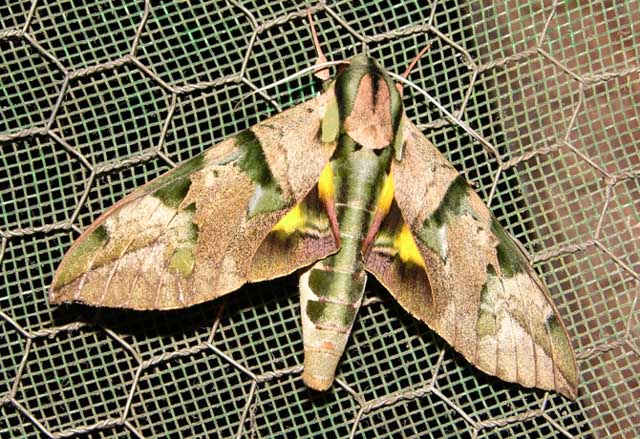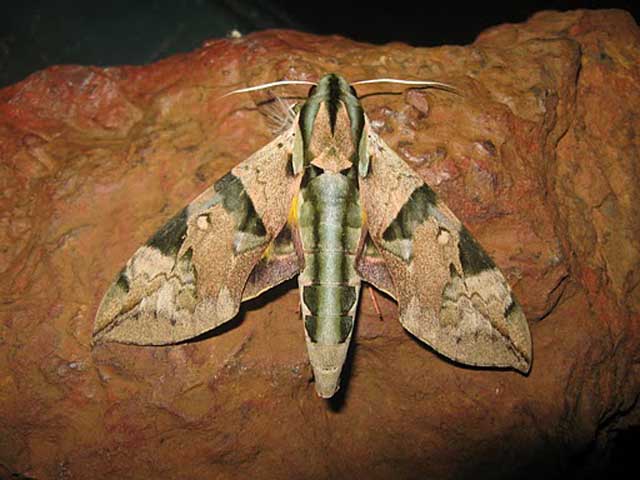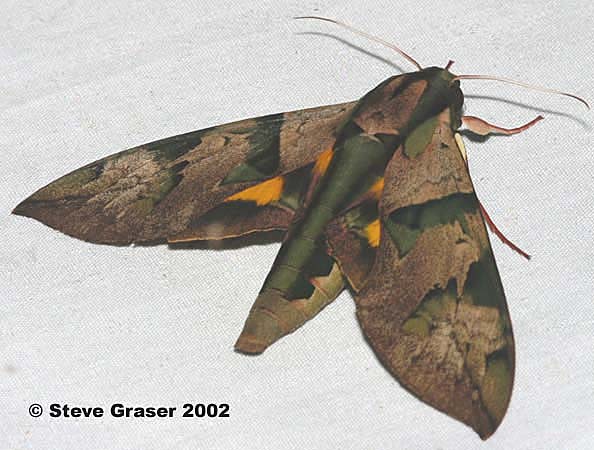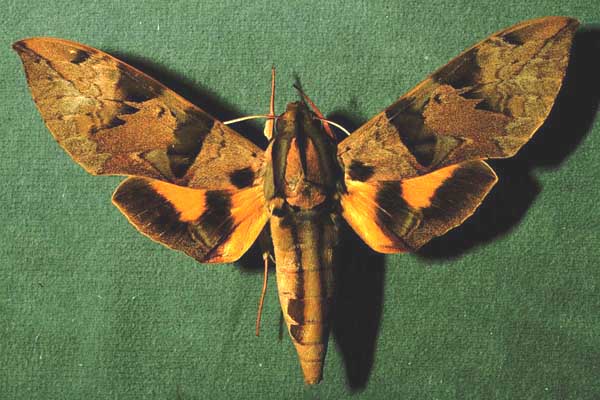Eumorpha capronnieri
|
|
Updated as per
AN ANNOTATED CHECKLIST OF THE SPHINGIDAE OF BOLIVIA, October 2007
Updated as per More, Kitching and Cocucci's Hawkmoths of Argentina 2005, October, 2007
Updated as per Fauna Entomologica De Nicarauga, November 2007
Updated as per The Known Sphingidae of Costa Rica, November 2007
Updated as per personal communication with Johan van't Bosch (Mato Grosso, Brazil, September 10), March 2008
Updated as per CATE; (Ecuador, Peru, Venezuela, Guyana, French Guiana, Brazil); February 13, 2011
Updated as per personal communication with Andres Urbas (near Kaw Mountains, French Guiana, April 1, 2011); April 19, 2011
Updated as per personal communication with Johan van't Bosch (Stoelmanseiland, Sipaliwini, Suriname, July 23, 2011), November 21, 2012
|
Eumorpha capronnieri
you-MOR-fuhMkagh-PRON-nee-air-eye
(Boisduval, [1875])
Philampelus

Eumorpha capronnieri, Cristalino Jungle Lodge, Mato Grosso, Brazil,
September 10, 2007, 71m, courtesy/copyright of Johan van't Bosch.
This site has been created by
Bill Oehlke at oehlkew@islandtelecom.com
Comments, suggestions and/or additional information are welcomed by Bill.
| TAXONOMY:
Superfamily: Sphingoidea, Dyar, 1902
Family: Sphingidae, Latreille, 1802
Subfamily: Macroglossinae, Harris, 1839
Tribe: Philampelini, Burmeister
Genus: Eumorpha, Hubner, [1807]
Species: capronnieri, (Boisduval, [1875]) |
MIDI MUSIC
"What.A.Wonderful.World"
copyright C. Odenkirk
MIDI CITY
ON.OFF
<bgsound src="world.mid" LOOP=FOREVER>
|
DISTRIBUTION:
Eumorpha capronnieri
(wingspan 102-106 mm) flies from
French Guiana: Kaw, Saul; to
southern Nicaragua: Rio San Juan, Zelaya;
Costa Rica: Guanacaste, Limon, Alajuela,
Heredia; and
probably Panama;
southwards to
Bolivia: Beni: Yacuma (1000-1700m);
northern Argentina.
It is also likely present in
Panama;
Colombia;
Venezuela;
Tobago;
probably Trinidad;
Guyana: Georgetown;
Suriname: Sipaliwini District: Stoelmanseiland (JvB);
Ecuador: Orellana;
Peru: Merced;
Brazil: Amapa, Roraima, Amazonas, Para,
Rondonia, Acre, Mato Grosso.
 Eumorpha capronnieri is somewhat similar to Eumorpha phorbas, but capronnieri
has a distinct forewing upperside pattern of mottled green and brown areas. The forewing apex is slightly more
produced and pointed in capronnieri.
Eumorpha capronnieri is somewhat similar to Eumorpha phorbas, but capronnieri
has a distinct forewing upperside pattern of mottled green and brown areas. The forewing apex is slightly more
produced and pointed in capronnieri.
Note the outward extensions of dark green-brown stripes on abdominal tergites 5 and 6.

Eumorpha capronnieri, Stoelmanseiland, Sipaliwini District, Suriname,
July 23, 2011, courtesy of Johan van't Bosch.
"Eumorpha" means well-formed. The species is probably
named after a friend, collector or colleague. In such cases, practice
is to say the name followed by an "eye".
The pronunciation of scientific names is
troublesome for many. The "suggestion" at the top of the page is
merely a suggestion. It is based on commonly
accepted English pronunciation of Greek names and/or some
fairly well accepted "rules" for latinized scientific names.
The suggested pronunciations, on this page and on other pages,
are primarily put forward to assist those who hear with internal
ears as they read.
There are many collectors from different countries whose
intonations and accents would be different.

Eumorpha capronnieri male, courtesy of Hubert Mayer
copyright.
FLIGHT TIMES AND PREFERRED FOOD PLANTS:
Eumorpha capronnieri broods continuously with adults on the
wing every month of the year, except March, in Costa Rica.
Johan van't Bosch reports a September flight in Mato Grosso, Brazil, and a July flight in Suriname.
It probably also flies in other months. February and August flights have been reported in French Guiana.
Adults nectar at various flowers.
Eumorpha capronnieri larvae probably feed upon grapes
(Vitaceae), dogbane (Apocynaceae), or evening primrose (Onagraceae)
families.

Eumorpha capronnieri Yasuni, Ecuador,
September 6, 2002 - 9:33 PM, by Steve Graser.
ECLOSION, SCENTING AND MATING:
Pupae wiggle to surface just prior to eclosion. Females call at night, and males (below) fly into the wind to pick up and track the pheromone plume.

Eumorpha capronnieri male courtesy of Dan Janzen.

Eumorpha capronnieri female courtesy of Dan Janzen.
EGGS, LARVAE AND PUPAE:
Larval Food Plants
Listed below are primary food plant(s) and alternate food plants. It is hoped that this
alphabetical listing followed by the common name of the foodplant will
prove useful. The list is not exhaustive. Experimenting with closely
related foodplants is worthwhile.
Use your browser "Back" button to return to the previous page.
Return to U. S. A. Table
Return to Philampelini Index
Return to Sphingidae Index






